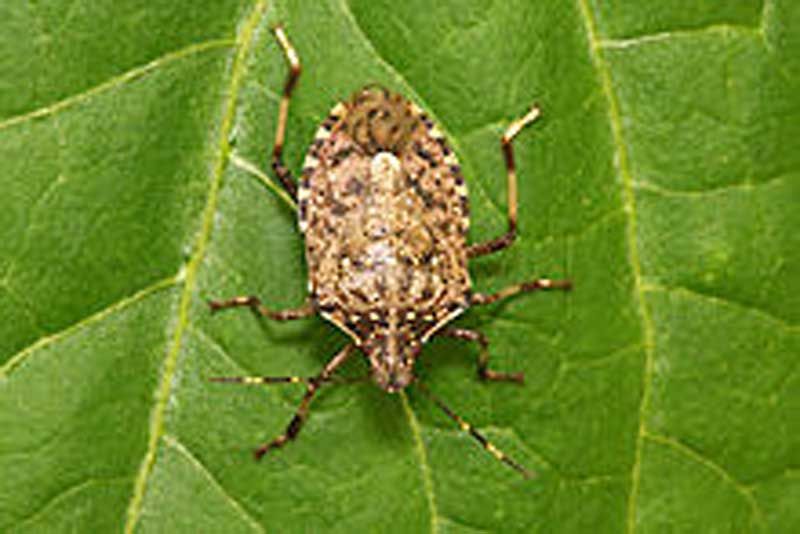Apr 24, 2014
by Lorraine Julien
How suitable this name is! Are you familiar with stink bugs? I found a little stink bug on a planter last summer and thought it was kind of cute – certainly distinctive with the weird “shield” shape.
We have lots of native stink bugs but a new, non-native, and very destructive variety, is making itself at home over a good portion of eastern North America. It’s the Brown Marmorated Stink Bug (BMSB). This invasive species is native to China, Japan, Korea and Taiwan.
BMSB was accidentally introduced to North America in the 1990s; they probably hitch-hiked overseas in a shipping crate. It was first noticed in Pennsylvania and has been spreading rapidly since - a major concern for farmers as it loves to feast on fruit, veggies and other crops. For example, in 2010 alone, the U.S. Apple Association reported (BMSB) caused $37million U.S. in losses. BMSB begins feeding on crops in late May or early June on a wide range of fruits and vegetables.
It is a sucking insect (a true bug) that uses its proboscis (long tubular mouth part) to pierce the host plant in order to feed. BMSB has a wide host range that includes agricultural crops such as tree fruit, nuts, small fruit, grapes, tomatoes, peppers, sweet corn, soybeans, grain crops and ornamentals. It will also feed and reproduce on many deciduous trees and shrubs commonly found in southern Ontario (Maple, Ash, Lilac, Buckthorn, to name a few). Once the BMSB starts to feed apples and other fruit look like they’ve been badly bruised. The subsequent brown patches are not very attractive and look like the plant is rotting.
The first official detection of BMSB in Canada came in 2012 when a homeowner in Hamilton found one. BMSB has also shown up in the GTA and Windsor and is spreading rapidly. As public awareness increases, there will likely be many more sightings and evidence that they’ve spread further.
While BMSB has not been identified in any agricultural crops to date, growers should be on the lookout for their activity both indoors (overwintering adults) and outdoors (on crops and landscape plants).
Spring is when adult BMSB emerge from the warm confines of where they spent the winter, usually attics, soffits, underneath sidings, chimneys or any space which has openings big enough to fit through. Once inside the house, they go into a state of hibernation. They wait for the winter to pass but sometimes the warmth inside the house may cause them to become active and they may fly clumsily around light fixtures.
The BMSB is similar in appearance to other native species of stink or shield bugs. They have the “shield” shaped characteristic of other stink bugs. They have various shades of brown on the top and undersides with gray, off-white, black, copper and bluish markings. What is different about this stink bug are the alternating light bands on the antennae and dark alternating bands on the outer edge of the abdomen. The legs are brown with white mottling or banding. Adults are approximately 0.67 inches long (1.7 cm) and about as wide.
All stink bugs have the ability to emit odour through holes in the abdomen. This is a defence mechanism to prevent them from being eaten by birds and lizards. Even if you simply pick up a bug, the odour release mechanism will be triggered. Apparently it is a pungent smell, something like coriander.
For information and tips on how to distinguish BMSB from other stink bugs and similar looking insects, visit the Ontario Ministry of Agriculture and Food website at www.ontario.ca/stinkbug or email the Agricultural Information. Contact Centre – This email address is being protected from spambots. You need JavaScript enabled to view it. or 1-877-424-1300. The agriculture ministry is asking anyone in Ontario who finds a stink bug to catch it, take a photo and send the picture to the ministry.
The best way to preserve specimens, and to prevent them from being crushed, is to place them in a small container and immerse them in rubbing alcohol or vinegar. Good quality digital photos, showing key features such as the two white bands on each antenna, will be useful in identifying BMSB.
U.S. officials are trying to determine if any species in North America prey on this bug – they’ve even travelled to Asia to find natural predators. For updates on BMSB pest management research efforts, visit www.stopbmsb.org.
Please feel free to report any observations to Lorraine Julien at This email address is being protected from spambots. You need JavaScript enabled to view it. or Steve Blight at This email address is being protected from spambots. You need JavaScript enabled to view it.
More Stories
- Province clarifies stance - Says Private Well Water Testing Will Continue
- Frontenac County Stays Internal for CAO - Appoints Kevin Farrell
- Addington Highlands Tax Bill Going Up 6.93%
- Perth Road United Church Donation to The Grace Centre
- 21 Years Of Dump Life Left At South Frontenac Waste Site
- Eclipse 2024 – Once In A Lifetime
- National Tourism Week
- NeLL Spring Open House and Anniversary Concert
- 25 years at Bishop Lake Outdoor Centre
- Grounds Contracts Down, Custodial Contracts Up In Central Frontenac

